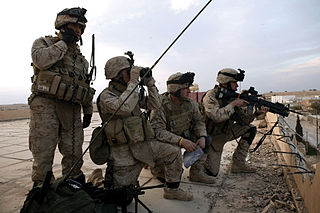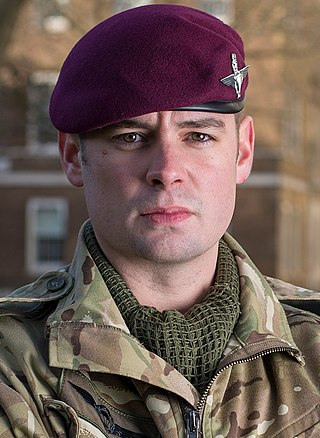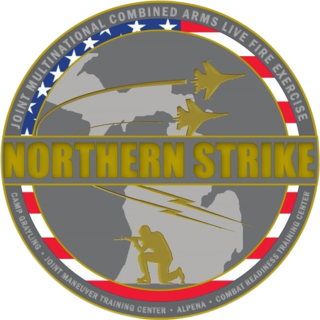Related Research Articles

The Special Boat Service (SBS) is the special forces unit of the United Kingdom's Royal Navy. The SBS can trace its origins back to the Second World War when the Army Special Boat Section was formed in 1940. After the Second World War, the Royal Navy formed special forces with several name changes—Special Boat Company was adopted in 1951 and re-designated as the Special Boat Squadron in 1974—until on 28 July 1987 when the unit was renamed as the Special Boat Service after assuming responsibility for maritime counter-terrorism. Most of the operations conducted by the SBS are highly classified, and are rarely commented on by the British government or the Ministry of Defence, owing to their sensitive nature.

The AgustaWestland Apache is a licence-built version of the Boeing AH-64D Apache Longbow attack helicopter for the British Army Air Corps. The first eight helicopters were built by Boeing; the remaining 59 were assembled by Westland Helicopters at Yeovil, Somerset in England from Boeing-supplied kits. Changes from the AH-64D include Rolls-Royce Turbomeca RTM322 engines, a new electronic defensive aids suite and a folding blade mechanism allowing the British version to operate from ships. The helicopter was initially designated WAH-64 by Westland Helicopters and was later given the designation Apache AH Mk 1 by the Ministry of Defence.

Air Naval Gunfire Liaison Company (ANGLICO) is an airborne fire support and liaison unit of the United States Marine Corps. The mission of ANGLICO is "To provide Marine Air-Ground Task Force (MAGTF) Commanders a liaison capability to plan, coordinate, and conduct terminal control of fires in support of joint, allied, and coalition forces. Per this mission statement, ANGLICOs are not designed to support U.S. Marine Corps maneuver elements. Instead, the doctrinal purpose of ANGLICO is to provide fire support and coordination in support of units adjacent to the MAGTF.

Sangin is a town in Helmand province of Afghanistan, with a population of approximately 20,000 people. It is located on 32°4′24″N64°50′2″E in the valley of the Helmand River at 888 m (2,913 ft) altitude, 95 km (59 mi) to the north-east of Lashkargah. Sangin is notorious as one of the central locations of the opium trade in the south of the country, and is also a town that has traditionally supported the Taliban. It was described by British newspaper The Guardian as "the deadliest area in Afghanistan" in 2010. Sangin also houses the main bazaar for Sangin District. Route 611 passes through Sangin.

The United Kingdom was one of the first countries to take part in Operation Enduring Freedom against the Taliban regime in autumn 2001.

Operation Herrick was the codename under which all British operations in the War in Afghanistan were conducted from 2002 to the end of combat operations in 2014. It consisted of the British contribution to the NATO-led International Security Assistance Force (ISAF), and support to the American-led Operation Enduring Freedom (OEF), within the South Asian country.

Nāwa-I-Barakzāyi District is an administrative district in Helmand Province, Afghanistan located south of the provincial capital of Lashkar Gah along the Helmand River. It is bordered by the districts of Lashkar Gah, Nad Ali, Garmsir, and Rig, as well as the provinces of Nimruz and Kandahar. It falls within the area known as Pashtunistan,, an area comprising most of southeast Afghanistan and northwest Pakistan. The dominant language is Pashto and many of the 89,000 residents practice the traditional code of Pashtunwali. Nawa-I-Barakzayi's name reflects the dominant Pashtun tribe in the district, the Barakzai. Prior to the 1970s, it was called Shamalan after a small village at the south end of the district
The Friendly fire incident at Sangin was a military incident that took place on March 29, 2006. Afghan insurgents mounted an assault on a forward operating base in Helmand province near the town of Lashkar Gah, which had been opened only six weeks earlier and was staffed by 100 ANA soldiers and their American trainers, using small arms fire, rocket-propelled grenades, and mortars.

The siege of Sangin was a military engagement which occurred between June 2006 and April 2007, between Taliban insurgents and the British army during the war in Afghanistan. During the engagement, the district centre of Sangin District in Helmand Province was occupied by British forces and was completely surrounded by Taliban fighters. At one point fighting became intensive, causing General David J. Richards, the then-NATO commander in Afghanistan, to declare that Helmand province had seen the fiercest fighting involving British troops since the Korean War. The siege became emblematic of the difficulty of the mission being carried out by British soldiers in Afghanistan, who nicknamed it "Sangingrad".

The Helmand province campaign was a series of military operations conducted by the International Security Assistance Force (ISAF) forces against Taliban insurgents and other local groups in the Helmand Province of Afghanistan. Their objective was to control a province that was known to be a Taliban stronghold, and a center of opium production. None of the ISAF's intended strategic and political objectives were achieved in the long term.

The siege of Musa Qala took place between July 17 and September 12, 2006 in Afghanistan's Helmand province. A small force of International Security Assistance Force (ISAF) troops and Afghan security forces were besieged by Taliban insurgents inside the district centre of Musa Qala.

Operation Strike of the Sword or Operation Khanjar was a US-led offensive in Helmand province in southern Afghanistan. About 4,000 Marines from the 2nd Marine Expeditionary Brigade as well as 650 Afghan troops were involved, supported by NATO planes. The operation began when units moved into the Helmand River valley in the early hours of July 2, 2009. This operation was the largest Marine offensive since the Battle of Fallujah in 2004. The operation was also the biggest offensive airlift by the Marines since the Vietnam War.
The Battle of Dahaneh was a battle in the town of Dahaneh, Helmand Province, and its surrounding areas as part of the Afghanistan War. It began when U.S. and Afghan troops launched an Operation to capture the town from the Taliban, in the Helmand Province of Southern Afghanistan. Coalition troops met heavy resistance, and believe the Taliban were forewarned of the incoming attack, though they were successful in securing Dahaneh.
Operation Moshtarak, also known as the Battle of Marjah, was an International Security Assistance Force (ISAF) pacification offensive in the town of Marjah, Helmand Province, Afghanistan. It involved a combined total of 15,000 Afghan, American, British, Canadian, Danish, and Estonian troops, constituting the largest joint operation of the War in Afghanistan up to that point. The purpose of the operation was to remove the Taliban from Marja, thus eliminating the last Taliban stronghold in central Helmand Province. The main target of the offensive was the town of Marjah, which had been controlled for years by the Taliban as well as drug traffickers.

Operation Tar Heels was a military operation launched by US Marines in Laghman Province, eastern Afghanistan. Patrols of around 30 men were ambushed in several places, but the Taliban attackers were driven back. The Marines lost team leaders Nicholas Kirven and Richard Schoener in the meantime. Otherwise, the operation to patrol Laghman Province was a success.

The September 2012 raid on Camp Bastion was a Taliban raid on Camp Bastion in Afghanistan's Helmand province on the night of 14 September 2012. The base hosted British, American, Danish and Tongan military personnel at the time of the attack. The Taliban fighters killed two U.S. Marines and destroyed or severely damaged eight U.S. Marine Corps AV-8B Harriers and a United States Air Force C-130 before the entire raiding force was killed or captured. The Taliban claimed that the raid was in response to the film, Innocence of Muslims, and have also stated that Prince Harry, who was stationed at the base at the time, was the target of the attack. To replace the aircraft lost in the attack, the USMC deployed 14 Harriers to Afghanistan 36 hours after the raid.
The following lists events that happened during 2015 in Afghanistan.

Colour Sergeant Joshua Mark Leakey is a British soldier currently serving in the Parachute Regiment. In 2015, Leakey was awarded the Victoria Cross, the highest military decoration for valour in the British and Commonwealth armed forces, for his involvement in a joint UK–US raid in Helmand Province, Afghanistan, on 22 August 2013. He was the only living British soldier to be awarded the Victoria Cross for the War in Afghanistan and the last person to receive it from Queen Elizabeth II.

The 2014 Gaza Valley airstrike was a friendly fire incident that took place in Zabul Province, Afghanistan on 9 June 2014 when five U.S. troops and one Afghan interpreter were killed when a B-1B Lancer bomber inadvertently dropped laser-guided bombs on their position during a firefight with Taliban forces. U.S. and Afghan government forces were in the Gaza Valley area of Arghandab District conducting security operations in advance of the 2014 Afghan presidential elections when they came under attack from Taliban militants, sparking a firefight. An American air controller on the ground requested close air support from a B-1B bomber flying in the vicinity to support a team of soldiers maneuvering on a ridge. The U.S. aircraft dropped two guided bombs on the position, killing the team of Americans and an Afghan soldier.

Exercise Northern Strike is a military readiness exercise hosted annually at Michigan National Guard facilities, including the Alpena CRTC, Camp Grayling Joint Maneuver Training Center, Grayling Aerial Gunnery Range, the Carmeuse Calcite Quarry in Rogers City, the former site of K.I. Sawyer Air Force Base as well as over the skies of northern Michigan and Lake Huron.
References
- ↑ Macy, E. (2008). Apache . HarperCollins. pp. 239–240. ISBN 978-0-00-728817-5.
- 1 2 3 4 Norton-Taylor, R. (16 August 2008). "Poor training, confusion and friendly fire, the real story behind brave Apache rescue". The Guardian . Retrieved 8 September 2012.
- 1 2 "Apache Hero's DFC Outstanding Story". Bosleys militaria auctioneers.
- 1 2 3 Walsh, Declan; Norton-Taylor, R. (17 January 2007). "Strapped to Apaches and dodging fire, how troops recovered fallen comrade". The Guardian .
- 1 2 Harding, Thomas (16 August 2008). "Royal Marine was shot by his own side 'due to inadequate training'". Daily Telegraph .
- 1 2 "A-10s Saved the Day in Botched Afghanistan Raid". War is Boring. 14 June 2014.
- 1 2 Logan Nye (16 October 2015). "That time 4 Royal Marines strapped themselves to attack helicopters and rode into a Taliban compound". We Are The Mighty.
- ↑ David Bathgate (August 2008). "Showdown at Jugroom Fort". The Digital Journalis.